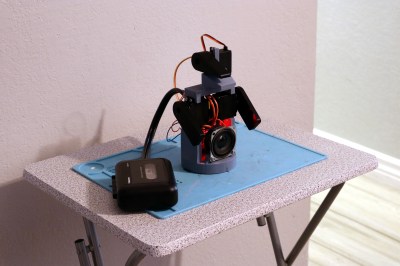What are you doing to scare trick-or-treaters this Halloween? Surely something, right? Well, Hackaday alum [CameronCoward] certainly has his holiday under control with Dead E. Ruxpin, a murderous, cassette tape-controlled animatronic bear.
 Readers of a certain vintage will no doubt see the correlation to Teddy Ruxpin, an animatronic bear from the 1980s whose mouth moved as it read stories from cassette tapes. Cleverly, the engineers used one stereo channel for the story’s audio, and the other channel to control the bear’s mouth.
Readers of a certain vintage will no doubt see the correlation to Teddy Ruxpin, an animatronic bear from the 1980s whose mouth moved as it read stories from cassette tapes. Cleverly, the engineers used one stereo channel for the story’s audio, and the other channel to control the bear’s mouth.
Dead E. Ruxpin takes this idea and expands it, using the same two channels to send audio and control three servo motors that move both arms and the mouth. How is this possible? By sending tones built from one or more frequencies.
Essentially, [Cameron] assigned a frequency to each movement: mouth open/closed, and left and/or right arm up or down. These are all, of course, synced up with specific points in the audio so Dead E. doesn’t just move randomly, he dances along with the music.
The bear is actually a hand puppet, which leaves room for a 3D-printed skeleton that holds the RP2040 and the servos and of course, moves the puppet’s parts. We can’t decide if we prefer the bulging bloodshot eyes, or think the cutesy original eyes would have made a scarier bear. Anyway, check out the build/demo video after the break to see it in action.
Are you now into Teddy Ruxpin? Here’s a bit more about those scare bears. And don’t forget, Halloween Hackfest runs now until October 31st.

















I can see this working really well connected to the Audio output of a soundcard, using software to generate the control tones and audio in real time based on other input.
It seems like using a pair of DTMF chips might have been easier. Especially if there were more channels required. That would negate the need to use fast Fourier transforms. Cliché aside, if you used some 555s for servo control, you wouldn’t need a microcontroller at all.
DTMF can only handle one frequency pair at a time and decoders are slow, making it hard to control actuators in a synchronized way. Adding 12 to 555 would do the trick, after being multiplied by 6.
Luckily it’s on tape, so it’s synchronised. Movement commands can be ahead of where they need to be to keep the timings in line with the audio. I doubt it would need to make too many adjustments in rapid enough succession for DTMF recognition to make much difference.
You’re still limited to a command every 80 ms and, if you want to trigger more than one actuator at exactly the same time, to four channels. A different approach would be to record analog values. Can be done by using FM-modulated carriers or by time-multiplexing the servo control pulses. The latter method was used for radio controlled models well before micrprocessors were affordable for such tasks and can be implemented with standard logic and some 555s or even with discrete parts. An 8 channel system needs less than 5 kHz bandwith, so it should be compatible with tape recorders.
No doubt it would accept any audio input, as long as you has the right peek to peek voltage etc. Desk toy that acts as a virtual assistant springs to mind.
Paper clip shaped perhaps. Jk.
You are correct! I like your virtual assistant idea and might steal that, haha.
Feel free, most of my ideas usually end up shelved during or even before I do much about them.
I’m a little surprised someone hasn’t taken this to the next step and made it a “Friday Night at Freddy’s” bear.
Guys we are so old that you could remake Hellraiser but with a walkman instead of the cube. Story: An ancient aparat that plays devilish verses from a plastic film and opens a gateway into a past dimension to the eighties. :-)
This reminds me of a Toy I had, now it didn’t move a knife around but a pen which is suppose to be mightier then the sword. Yes there was teddy ruxpin, but there was also skippy scribbles and susie scribbles. Me I wanted to tear skippy apart to figure out how he was able to write and draw but my sister wouldn’t let me. To me this project shares more with skippy scribbles and not so much with teddy ruxpin but everyone knows of teddy.
https://www.megadroid.com/Robots/susie_scribbles.htm
Cool project! Maybe next year you can make the eyes move wildly with something like https://s.click.aliexpress.com/e/_DldhU4f
Happy halloween!